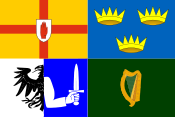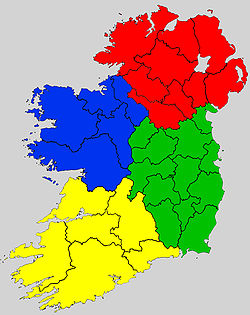- Provinces of Ireland
-
For ecclesiastical provinces, see List of Roman Catholic dioceses in Ireland and List of Anglican dioceses in the United Kingdom and Ireland.
Provinces of Ireland
Cúigí na hÉireann
"Flag of the Four Provinces"Location LeinsterMunsterConnachtUlsterStatistics Area: 84,421 km² Population (2011): 6,241,700 Ireland has historically been divided into four provinces: Leinster, Ulster, Munster and Connacht. The Irish word for this territorial division, cúige, literally meaning "fifth part", indicates that there were once five; the fifth province, Meath, was incorporated into Leinster, with parts going to Ulster.
Contents
History
The origins of these provinces (loosely federated kingdoms with somewhat flexible boundaries), of which there were five before the Norman invasion, can be traced to the overriding influence exerted in their respective territories by the great Irish dynastic families of Uí Néill/O'Neill (Ulster), Uí Máeilsheáchlainn/O'Melaghlin (Mide), Uí Briain/O'Brien (Munster), Uí Conchobhair/O'Conor (Connacht) and Mac Murchadha-Caomhánach/MacMurrough-Kavanagh (Leinster). A "king of over-kings", a rí ruirech was often a provincial (rí cóicid) or semi-provincial king to whom several ruiri were subordinate. Entities belonging to the 1st and 2nd millennia are listed. These do not all belong to the same periods. Over the centuries, the number of provincial kings varied between three and six. No more than six genuine rí ruirech were ever contemporary, with the average being three or four. Also, following the Norman invasion, the situation became somewhat more condensed and complicated than previously.
- Kings of Ulster
- Kings of Munster
- Kings of Mide
- Kings of Connacht (majority: O'Conor dynasty)
- Kings of Leinster (2nd millennium: Uí Cheinnselaig)
After the Norman invasion
In the post-Norman period the historic provinces of Leinster and Meath gradually merged, mainly due to the impact of the Pale, which straddled both, thereby forming the present-day province of Leinster. In the Irish Annals these five ancient political divisions were invariably referred to as cúigí ("fifths") such as the fifth of Munster, the fifth of Ulster and so on. Later record-makers dubbed them provinces, in imitation of the Roman imperial provinciae.
In modern times they have become associated with groups of counties, although they have no legal status. They are today seen mainly in a sporting context, as Ireland's four professional rugby teams play under the names of the provinces, and the Gaelic Athletic Association has separate GAA provincial councils and Provincial championships.
The provinces were supplanted by the present system of counties after the Norman invasion.
Six of the nine Ulster counties form modern-day Northern Ireland, which is part of the United Kingdom of Great Britain and Northern Ireland. Northern Ireland is sometimes called a province of the United Kingdom. These two inconsistent usages of the word "province" (along with the use of the term "Ulster" to describe Northern Ireland) can cause confusion.
Demographics and politics
Province Flag Irish name Population (2011) Area (km²) Number of
Counties†Chief city Leinster 
Laighin
Cúige Laighean2,501,208 19,800 12 Dublin Ulster 
Ulaidh
Cúige Uladh1,954,727‡ 21,882 9 Belfast Munster 
Mumhain
Cúige Mumhan1,243,726 24,675 6 Cork Connacht 
Connachta
Cúige Chonnacht542,039 17,788 5 Galway Note 1: † "Number of Counties" is traditional counties, not administrative ones.
Note 2: ‡ Population for Ulster is the sum of the 2011 census results for counties of Ulster in Republic of Ireland and the 2006 estimated population for Northern Ireland.[1] Population for other provinces is all 2011 census results.Poetic description
 Flag of Mide, the former fifth province of Ireland
Flag of Mide, the former fifth province of Ireland
This dinnseanchas poem named Ard Ruide (Ruide Headland) poetically describes the kingdoms of Ireland. Below is a translation from Old Irish:
“ Connacht in the west is the kingdom of learning, the seat of the greatest and wisest druids and magicians; the men of Connacht are famed for their eloquence, their handsomeness and their ability to pronounce true judgement. Ulster in the north is the seat of battle valour, of haughtiness, strife, boasting; the men of Ulster are the fiercest warriors of all Ireland, and the queens and goddesses of Ulster are associated with battle and death.
Leinster, the eastern kingdom, is the seat of prosperity, hospitality, the importing of rich foreign wares like silk or wine; the men of Leinster are noble in speech and their women are exceptionally beautiful.
Munster in the south is the kingdom of music and the arts, of harpers, of skilled ficheall players and of skilled horsemen. The fairs of Munster were the greatest in all Ireland.
The last kingdom, Meath, is the kingdom of Kingship, of stewardship, of bounty in government; in Meath lies the Hill of Tara, the traditional seat of the High King of Ireland. The ancient earthwork of Tara is called Rath na Ríthe ('Ringfort of the Kings').
” See also
- Rí
- Counties of Northern Ireland
- ISO 3166-2:IE
References
- ^ World Gazetteer, Northern Ireland
Counties of Ireland The counties are listed per provinceConnacht Munster Leinster Ulster Italics denote non-administrative counties. Brackets denote eponymous cities or non-traditional counties. † denotes counties of Northern IrelandCategories:- Historical regions
- Provinces of Ireland
- Subdivisions of Ireland
Wikimedia Foundation. 2010.


